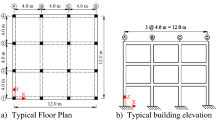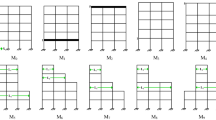Abstract
The need for industrial buildings has increased multifold, with a wide range in the irregular distribution of floor mass and stiffness. The uneven distribution of floor mass causes mass eccentricity in the floor, inducing torsion in the building. The aim of the present study is to highlight the influence of torsional irregularity due to mass eccentricity on the multi-directional floor response spectra. IS 1893 (Part 4): 2015 suggested time-history analysis of the design basis earthquake to develop floor response spectra, adopting linear analysis technique. Eleven sets of real orthogonal records were chosen to perform time-history analysis to obtain a mean response. The present study observed that the building’s with regular geometry and without stiffness variation in it, a slight mass eccentricity significantly increases floor response spectra. Moreover, actual industrial buildings have significant variations in mass, stiffness, and strength, resulting in further intensifying floor response spectra. Thus, the structural designer needs to use tri-directional floor response spectra for precise and protective non-structural component support design for appropriate response. IS 1893 (Part 1): 2016 suggests reduced stiffness for beam and column for earthquake analysis. Floor response spectra with reduced stiffness were also studied here, and the response was compared with non-linear analysis. Non-structural components lateral design forces as per floor response spectra approach and Indian Standard provisions are also included in the study.









Similar content being viewed by others
References
Perrone D, Calvi PM, Nascimbene R, Fischer EC, Magliulo G (2019) Seismic performance of non-structural elements during the 2016 Central Italy earthquake. Bull Earthq Eng 17(10):5655–5677. https://doi.org/10.1007/s10518-018-0361-5
Biggs JM, Roesset JM (1970) Seismic analysis of equipment mounted on a massive structure. In: Seismic design of nuclear power plants, MIT press.
USNRC Regulatory Guide 1.122 (1978) Development of floor design response spectra for seismic design of floor-supported equipment or components, Rev. 1
Adam C (2001) Dynamics of elastic-plastic shear frames with secondary structures: shake table and numerical studies. Earthquake Eng Struct Dynam 30(2):257–277. https://doi.org/10.1002/1096-9845(200102)30:2%3c257:AID-EQE7%3e3.0.CO;2-J
Agarwal AK, Datta TK (2003) Response of multiple-supported secondary system on torsionally coupled yielding primary system. Advances in Vibration Engineering 2(4):115–124
Amin M, Hall WJ, Newmark NM, Kassawara RP (1971) Earthquake response of multiply connected light secondary systems by spectrum methods. In: Proceedings of the 1st national conference on pressure vessels and piping, New York 103–29.
Bradley BA (2012) A ground motion selection algorithm based on the generalized condition intensity measure approach. Soil Dyn Earthq Eng 40:48–61. https://doi.org/10.1016/j.soildyn.2012.04.007
Lucchini A, Franchin P, Mollaioli F (2017) Spectrum-to-spectrum methods for the generation of elastic floor acceleration spectra. Procedia engineering 199:3552–3557. https://doi.org/10.1016/j.proeng.2017.09.514
Menon A, Magenes G (2011) Definition of seismic input for out-of-plane response of masonry walls: II. Formulation Journal of Earthquake Engineering 15(2):195–213. https://doi.org/10.1080/13632460903456981
Singh AK, Ang AH (1974) Stochastic prediction of maximum seismic response of light secondary systems. Nucl Eng Des 29(2):218–230. https://doi.org/10.1016/0029-5493(74)90124-1
Singh MP (1980) Seismic design input for secondary systems. J Struct Div 106(2):505–517. https://doi.org/10.1061/JSDEAG.0005371
Surana M, Singh Y, Lang DH (2018) Floor spectra of inelastic RC frame buildings considering ground motion characteristics. J Earthquake Eng 22(3):488–519. https://doi.org/10.1080/13632469.2016.1244134
Villaverde R (2004) Seismic analysis and design of non-structural components. Earthquake engineering: from engineering seismology to performance-based engineering. CRC, Boca Raton, 1156–1220.
Vukobratovic V, Fajfar P (2015) A method for the direct determination of approximate floor response spectra for SDOF inelastic structures. Bull Earthq Eng 13(5):1405–1424. https://doi.org/10.1007/s10518-014-9667-0
Medina RA, Sankaranarayanan R, Kingston KM (2006) Floor response spectra for light components mounted on regular moment-resisting frame structures. Eng Struct 28(14):1927–1940. https://doi.org/10.1016/j.engstruct.2006.03.022
Fragiadakis M, Vamvatsikos D, Papadrakakis M (2005) Evaluation of the influence of vertical Stiffness irregularities on the seismic response of a 9-storey steel frame. In Proceedings of the 4th European workshop on the seismic behavior of irregular and complex structures, CD ROM. Thessaloniki.
Singh MP, Moreschi LM, Suarez LE, Matheu EE (2006a) Seismic design forces I: Rigid non-structural components. J Struct Eng 132(10):1524–1532. https://doi.org/10.1061/(ASCE)0733-9445(2006)132:10(1524)
Singh MP, Moreschi LM, Suarez LE, Matheu EE (2006b) Seismic design forces I: flexible non-structural components. J Struct Eng 132(10):1533–1543. https://doi.org/10.1061/(ASCE)0733-9445(2006)132:10(1533)
ASCE/SEI 7-16 (2016) Minimum Design Loads and Associated Criteria for Buildings and Other Structures. American Society of Civil Engineers, Reston, Virginia.
Duff C (1975) Simplified Method for Development of Earthquake Ground and Floor Response Spectra for Nuclear Power Plant Design. Technical Report. Atomic Energy of Canada Ltd., Sheridan Park, Ontario, Power Projects
Singh M (1975) Generation of seismic floor spectra. J Eng Mech Div 101(5):593–607
Biggs JM (1971) Seismic response spectra for equipment design in nuclear power plants, 1st SMIRT Conf., Berlin.
Kapur KK, Shao LC (1973) Generation of seismic floor response spectra for equipment design. ASCE, In Structural Design of Nuclear Plant Facilities
Chauduri SR, Villaverde R (2008) Effect of building non-linearity on seismic response of non-structural components: a parametric study. J of Earthquake Eng 134(4):661–670. https://doi.org/10.1061/(ASCE)0733-9445(2008)134:4(661)
Gupta AK (1990) Response Spectrum Method in Seismic Analysis and Design of Structures. Blackwell Scientific Publications, Boston, MA
Phan LT, Taylor AW (1996) State of the art report on seismic design requirements for non-structural building components. Report NISTIR 5857, National Institute of Standards and Technology, Gaithersburg, MD.
Politopoulos I (2010) Floor Spectra of MDOF nonlinear Structures. J of Earthquake Eng 14(5):726–742. https://doi.org/10.1080/13632460903427826
Soong TT (1994) Seismic behavior of non-structural elements state-of-the-art report. In: Proceedings, 10th European conference on earthquake engineering.
Yasui Y, Yoshihara J, Takeda T, Miyamoto A (1993) Direct generation method for floor response spectra. In: Proceedings of the 12th International Conference on Structural Mechanics in Reactor Technology 13 (4).
An Y, Jiang Y, Ly B (2013) Direct generation of RRS from FRS. In: Proceedings of the 22nd International Conference on Structural Mechanics in Reactor Technology.
Chen YQ, Soong TT (1988) Seismic response of secondary systems. Eng Struct 10(4):218–228. https://doi.org/10.1016/0141-0296(88)90043-0
Der Kiureghian A, Sackman J, Nour-Omid B (1983) Dynamic analysis of light equipment in structures: response to stochastic input. J Eng Mech 109(1):90–110. https://doi.org/10.1061/(ASCE)0733-9399(1983)109:1(73)
Igusa T, Der Kiureghian A (1985) Dynamic characterization of two-degree-of-freedom equipment-structure systems. J Eng Mech 111(1):1–19. https://doi.org/10.1061/(ASCE)0733-9399(1985)111:1(1)
Lai ML, Soong TT (1991) Seismic design considerations for secondary structural systems. J Struct Eng 117(2):459–472. https://doi.org/10.1061/(ASCE)0733-9445(1991)117:2(459)
Villaverde R (1997) Seismic design of secondary structures: state of the art. J Struct Eng 123(8):1011–1019. https://doi.org/10.1061/(ASCE)0733-9445(1997)123:8(1011)
IS 1893-Part 4 (2015) Criteria for earthquake resistant design of structures. Industrial structures including stack like structures. Bureau of Indian Standards, New Delhi, India.
IS 1893-Part 1 (2016) Criteria for earthquake resistant design of structures. General provision and buildings. Bureau of Indian Standards, New Delhi, India.
Pacific Earthquake Engineering Research Center (2005) PEER Ground Motion https://ngawest2.berkeley.edu/ Accessed 28 March 2020.
CSI, version 21 (2018) Integrated finite element analysis and design of structures basic analysis reference manual. Computers and Structures Inc, Berkeley (CA, USA).
IS 13920 (2016) Ductile Design and Detailing of Reinforced Concrete Structures Subjected to Seismic Forces –Code of Practice. Bureau of Indian Standards, New Delhi, India.
IS 16700 (2017) Criteria for structural safety of tall Concrete buildings –Code of Practice. Bureau of Indian Standards, New Delhi, India.
IS 456 (2000) Plain and Reinforced Concrete – Code of Practice (Fourth Revision). Bureau of Indian Standards, New Delhi, India.
IS 875-Part 1 (1987) Code of Practice for Design Loads (other than Earthquake) for Buildings and Structures: Part 1-Dead Loads (second revision). Bureau of Indian Standards, New Delhi, India.
IS 875-Part 2 (1987) Code of Practice for Design Loads (other than earthquake) for Buildings and Structures: Part 2- Imposed Loads (second revision). Bureau of Indian Standards, New Delhi, India.
Kumar R, Singh Y, Tripathi S (2011) Effect of building performance on floor response spectra. J Struct Eng (Madras) 37(6):422–426
Suarez LE, Singh MP (1987) Floor response spectra with structure–equipment interaction effects by a mode synthesis approach. Earthquake Eng Struct Dynam 15(2):141–158. https://doi.org/10.1002/eqe.4290150202
Araujo M, Macedo L, Marques M, Castro JM (2016) Code-based record selection methods for seismic performance assessment of buildings. Earthq Eng Struct 45(1):129–148. https://doi.org/10.1002/eqe.2620
Baker JW (2007) Measuring bias in structural response caused by ground motion scaling. 8th Pacific Conference on Earthquake Engineering, Singapore, Paper No. 56, CD ROM proceedings.
Cantagallo C, Camata G, Spacone E (2014) Seismic demand sensitivity of reinforced concrete structures to ground motion selection and modification methods. Earthq Spectra 30(4):1449–1465. https://doi.org/10.1193/062812EQS226M
Katsanos EI, Sextos AG, Manolis GD (2010) Selection of earthquake ground motion records: a state-of-the-art review from a structural engineering perspective. Soil Dyn Earthq Eng 30(4):157–169. https://doi.org/10.1016/j.soildyn.2009.10.005
Bradley BA (2013) A critical examination of seismic response uncertainty analysis in earthquake engineering. Earthquake Eng Struct Dynam 42(11):1717–1729. https://doi.org/10.1002/eqe.2331
Grant DN, Diaferia R (2013) Assessing adequacy of spectrum-matched ground motions for response history analysis. Earthquake Eng Struct Dynam 42(9):1265–1280. https://doi.org/10.1002/eqe.2270
Hancock J, Bommer JJ, Stafford PJ (2008) Numbers of scaled and matched accelerograms required for inelastic dynamic analyses. Earthquake Eng Struct Dynam 37(14):1585–1607. https://doi.org/10.1002/eqe.827
Senaldi I, Magenes G, Penna A, Galasco A, Rota M (2014) The effect of stiffened floor and roof diaphragms on the experimental seismic response of a full-scale unreinforced stone masonry building. J Earthquake Eng 18(3):407–443. https://doi.org/10.1080/13632469.2013.876946
Baker JW (2011) Conditional mean spectrum: tool for ground-motion selection. J Struct Eng 137(3):322–331. https://doi.org/10.1061/(ASCE)ST.1943-541X.0000215
Bommer JJ, Acevedo AB (2004) The use of real earthquake accelerogram as input to dynamic analysis. J Earthq Eng 8(1):43–91. https://doi.org/10.1080/13632460409350521
Krawinkler H, Medina R, Alavi B (2003) Seismic drift and ductility demands and their dependence on ground motions. Eng Struct 25(5):637–653. https://doi.org/10.1016/S0141-0296(02)00174-8
Kumbhar OG, Kumar R (2020) Performance assessment of RC frame designed using force, displacement & energy-based approach. Structural Engineering and Mechanics 73(6): 699–714. https://doi.org/10.12989/sem.2020.73.6.699
Landge MV, Ingle RK (2020) Comparative study of floor response spectra for regular and irregular buildings subjected to earthquake. Asian Journal of Civil Engineering 22:49–58. https://doi.org/10.1007/s42107-020-00297-1
Shooshtari M, Saatcioglu M, Naumoski N, Foo S (2010) Floor response spectra for seismic design of operational and functional components of concrete buildings in Canada. Can J Civ Eng 37(12):1590–1599. https://doi.org/10.1139/L10-094
Rodriguez ME, Restrepo JI, Carr AJ (2002) Earthquake induced floor horizontal accelerations in buildings. Earthquake Eng Struct Dynam 31(3):693–718. https://doi.org/10.1002/eqe.149
Uma SR, Zhao JX, King AB (2010) Seismic actions on acceleration sensitive non-structural components in ductile frames. Bull N Z Soc Earthq Eng 43(2):110–125. https://doi.org/10.5459/bnzsee.43.2.110-125
Singh MP, Chang TS, and Suarez LE (1996) Floor response spectrum amplification due to yielding of supporting structure. In Proceedings of 11th World Conference on Earthquake Engineering.
Maddaloni G, Magliulo G, Cosenza E (2012) Effect of the seismic input on non-linear response of R/C building structures. Adv Struct Eng 15(10):1861–1877. https://doi.org/10.1260/1369-4332.15.10.1861
Petrone C, Magliulo G, Manfredi G (2015) Floor response spectra in RC frame structures designed according to Eurocode 8. Article in Bulletin of Earthquake Engineering 14(3):747–767. https://doi.org/10.1007/s10518-015-9846-7
Kanee ART, Kani IMZ, Noorzad A (2013) Elastic floor response spectra of non-linear frame structures subjected to forward-directivity pulses of near-fault records. Earthquakes and Structures Doi: https://doi.org/10.12989/eas.2013.5.1.049
Sankaranarayanan R, Medina RA (2007) Acceleration response modification factors for non-structural components attached to inelastic moment-resisting frame structures. Earthquake Eng Struct Dynam 36(14):2189–2210. https://doi.org/10.1002/eqe.724
ASCE/SEI 41-17 (2017) Seismic Evaluation and Retrofit of Existing Buildings. American Society of Civil Engineers, Reston, Virginia
Takeda T, Sozen MA, Nielsen NN (1970) Reinforced concrete response to simulated earthquakes. J Struct Div 96(12):2557–2573. https://doi.org/10.1061/JSDEAG.0002765
Flores FX, Garcia DL, Charney FA (2015) Assessment of floor accelerations in special steel moment frames. J Constr Steel Res 106:154–165. https://doi.org/10.1016/j.jcsr.2014.12.006
Wieser J, Pekcan G, Zaghi AE, Itani A, Maragakis M (2013) Floor accelerations in yielding special moment resisting frame structures. Earthquake Spectra 29(3):987–1002
Funding
No funding information available
Author information
Authors and Affiliations
Corresponding author
Ethics declarations
Conflict of interest
On behalf of all authors, the corresponding author states that there is no conflict of interest.
Rights and permissions
About this article
Cite this article
Landge, M.V., Ingle, R.K. Influence of torsional irregularity on tri-directional floor response spectra used in industrial buildings. Innov. Infrastruct. Solut. 7, 34 (2022). https://doi.org/10.1007/s41062-021-00639-1
Received:
Accepted:
Published:
DOI: https://doi.org/10.1007/s41062-021-00639-1




